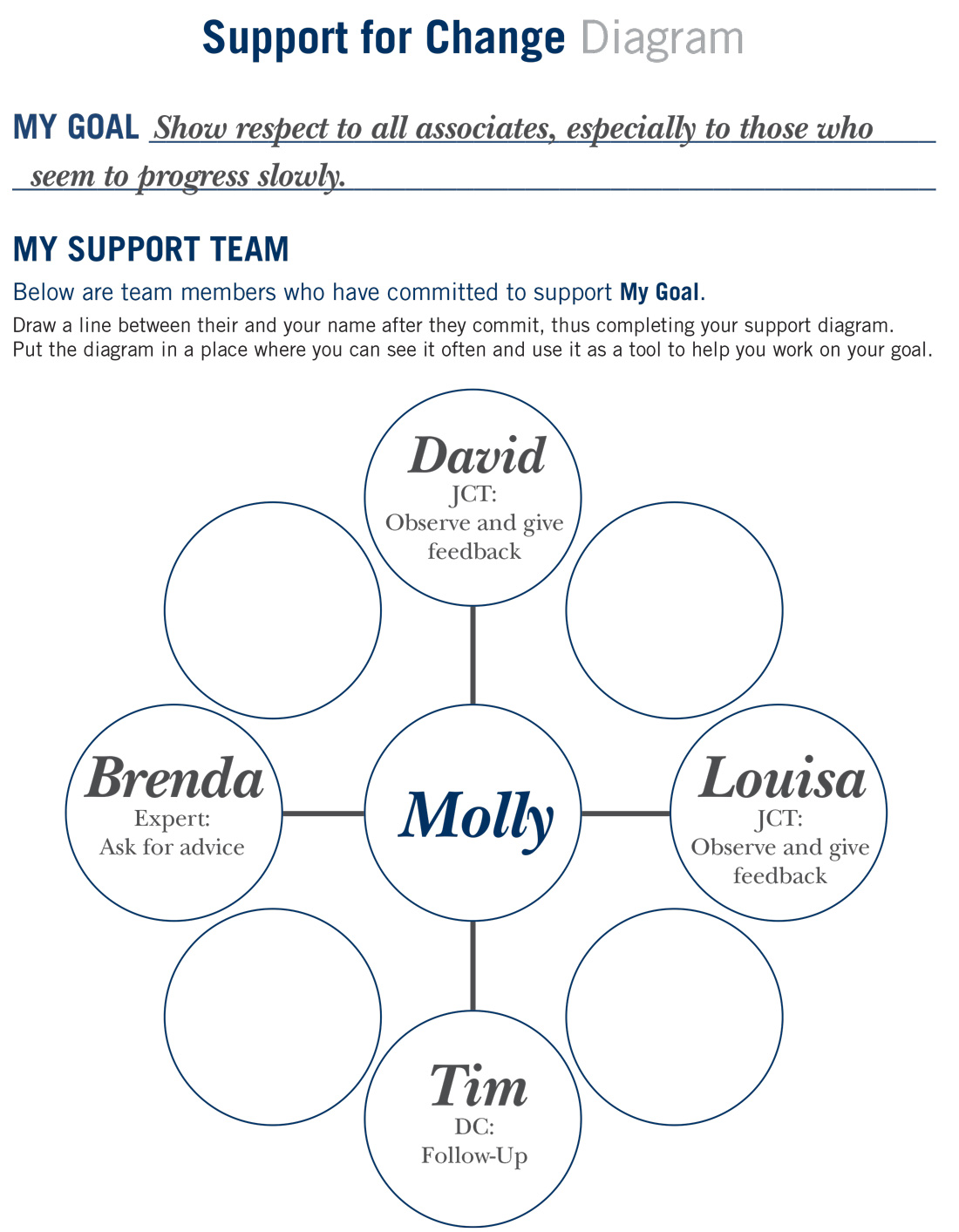Before coming to your training, please do the following:
At times, it is hard to know what gaps of knowledge and experience people have to fill in order to become self-reliant. It helps to know some of their background so that you can help them fill those gaps. Understanding a person’s socioeconomic background can give you insights into how to help that person. In this lesson, you will (1) become familiar with the patterns of two different economic classes, (2) make plans to strengthen your support system so that you can achieve one of your ATI goals, and (3) take these tools and apply them in your own life, as well as in your work with at least one of your associates.
Note: Remember that people come from all different circumstances and respond differently to their situations. While there may be some trends in how people from different socioeconomic classes might behave, it’s important to remember individuality. For example, a person who is highly educated and moves to the United States but speaks limited English will likely approach situations very differently from someone who has grown up in poverty in the United States, even if they make similar salaries.
From the following list, choose and complete one or more activities that best apply to your situation.
Review “The Hidden Rules of the Economic Classes,” and then read the class sketches included in the “Lesson Resources” section, Resource 1. As a group, try to identify which class each speaker likely belongs to.
After identifying the different socioeconomic backgrounds, discuss the following questions:
As a group, review “The Hidden Rules of the Economic Classes,” and choose four or five items you would like to focus on. Divide into pairs or small groups. Each group should focus on one or two items. Then come together and share what you have discussed with the class.
Discuss the following questions after completing the exercise:
Divide into small groups. Play the sorting game found in the “Lesson Resources” section, Resource 2. The groups will compete to correctly sort the squares into two piles (lower class or middle class). The first group to correctly sort the squares wins.
Consider the following questions as a group:
Elder L. Tom Perry said, “The spheres of influence we can radiate from our associations can make worthwhile contributions in the world” (“In the World,” Ensign, May 1988, 15). This section will discuss social capital and support systems (how others can support us in reaching our goals, as well as how we can support others).
From the following list, choose and complete one or more activities that best apply to your situation.
Read the following statement:
“Having social capital is not simply about how many people you know, how close you feel to them, or how many arrangements you have made with them. Rather, social capital is about where your contacts are within a social structure as well as the quality of their resources, including their own social capital (connections to others). Social capital is what we draw on when we get others, whether acquaintances, friends, or kin, to help us solve problems, seize opportunities, and accomplish other aims” (Deseret Employment update, third quarter [2014]).
Divide into small groups. Each group will choose a person to be “Taylor” in a role-play. This person will step out of the room for a moment. After Taylor has stepped out of the room, the remaining group members will be assigned a number between one and ten (each number should be different). The number assigned represents the social capital contact that each group member represents for Taylor (see Resource 3 of the “Lesson Resources” section). Each individual will then receive one item of currency from the Social Capital Handout (see Resource 4 of the “Lesson Resources” section). Individuals will write down which social capital contact they are, as well as a dollar amount from $1 to $10, based on how valuable they feel they would be as a resource to Taylor in getting a job at the factory.
Once this is finished, invite Taylor to return and give him or her the following instructions:
You want a job at the local factory in town. You are in need of a job and have to find a good lead quickly. You will approach a few group members for potential networking. Each time you approach a group member, that person will give you paper currency that shows how likely you are to get the position based on that connection. Your goal is to collect the highest amount of social capital. Due to time constraints, you will only be able to approach three individuals today. After you are done asking three individuals for help, compare the money received with the other Taylors in the meeting. Whoever has the most social capital wins the job.
After completing the activity, discuss the following questions as a group:
Use the “My Support for Change Plan” and the “Support for Change” diagram in Resource 5 of the “Lesson Resources” section to complete this activity. Use the example shown for “Molly” as a reference.
Part 1: Take a minute to identify individually an existing ATI goal that represents a major change for you. On the “My Support for Change Plan,” write your goal in the space provided. Then, write the names of people that might support your change and how you think they can help you (cheer you up, follow-up, counsel you, etc.). Ask the people you thought of to support you in your goal.
Part 2: After people commit to support you, complete the “Support for Change” diagram. Write your goal in the space provided next to “My Goal.” Write your name in the diagram’s center circle. Write the names of those who have committed to support your goal in the circles surrounding your name on the diagram.
Draw a line between each person’s name and yourself—the more support he or she is likely to give you, the thicker the line should be. Put the diagram in a place where you can see it often and use it as a tool to help you work on your goal.
Regroup with all attendees and discuss:
Separate into three groups, called A, B, and C. Each group will be assigned a situation to discuss from the situations in the “Lesson Resources” section, Resource 6. Begin with the scenarios in part 1 of the activity. Answer the following questions about your assigned situation:
After this discussion, read each group’s explanation from part 2 of the activity.
Seek to identify a personal or business gap or need.
Spend a few minutes silently pondering what you've discussed during this lesson. Listen as the Holy Ghost helps you identify areas where you can improve. Record your impressions in your learner's journal under the question “What Lack I Yet?”
Seek ways to close the gap or develop the required talent(s) to meet the need.
With the guidance of the Spirit, create your plan of how you will improve and close the gap(s) you have identified. You may use one or more of the exercises below, your own strategy, or a combination of both. Record this plan in your learner's journal under “What Must I Do?”
After a few minutes, those who are comfortable doing so can share their impressions with the group.
Seek understanding, and then share what you learned.
During the week, focus on implementing the plan you created. Record your impressions or lessons learned in your learner's journal under “Therefore, What?” You will be given time at the beginning of next week's lesson to share your experience with the group.
Example 1: Clothing
Carl: I may not have a lot of outfits, but the ones I do wear are top notch. I just wouldn’t feel right walking around with my friends in something out of a department store.
Example 2: Social Emphasis
Joseph: I never felt I was the center of any group. I do always try to have a story or joke to use with my coworkers. Those moments when I get them to react are just the highlights of my day! It helps me feel like I belong.
Example 3: What Drives Me
Alice: When I’m not visiting family, most of my week I’m just trying to get by. I can’t wait to spend time out with my girls this weekend! We’re going dancing!
Example 4: Prized Possessions
Jill: I just got a cute little car to get me to work. One of my girlfriends has one just like it, except hers has leather seats. I think I’m going to see how much it costs to upgrade. I sat in hers the other day and it felt wonderful!
Example 5: School
Yasir: Of course I’m going to continue my education! I plan to major in engineering. I just need to focus on other things right now, like putting food on the table and paying the rent. Maybe I’ll go back to school in a few years.
Example 6: The Future
Evelina: Every day this week I’ve been working on the project my boss assigned. If I can impress her with this I think she’ll take me on as her assistant—or even a project manager! I think I’ll stay late today to get a little extra work done.
Example 7: Food
Gary: I love buffets! I get as much as I want, and I’m always stuffed afterwards. I don’t have to worry about them skimping on the servings.
Example 8: Money
Wilma: I’ve always been good at keeping track of our money, so my husband lets me handle the bills. It’s how I was brought up.
Example 9: Power
Evelia: The other day I ran into an old friend that had been struggling to make ends meet. She felt like everything was against her. I could have just wished her the best and walked on, but I could see how difficult this had been for her. We sat for over an hour talking, and I convinced her to look into a great program I’d heard about through my work.
Example 10: Family Structure
Godofredo: When grandmother speaks, we all listen. She told me what school I should attend, and what job I should pursue. She even told me what kind of wife I needed. My wife is going to be a lot like grandmother.
Answers
Example 1: Middle
Example 2: Lower
Example 3: Lower
Example 4: Middle
Example 5: Lower
Example 6: Middle
Example 7: Lower
Example 8: Middle
Example 9: Middle
Example 10: Lower
Facilitator: See instructions in the Facilitator’s Guide.

The following individuals represent Taylor’s social capital.



From Marvin J. Ashton, “Progress through Change,” Conference Report, Oct. 1979, 86–90.




